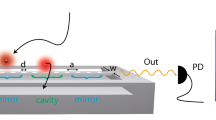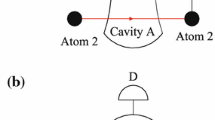Abstract
It has long been recognized that atomic emission of radiation is not an immutable property of an atom, but is instead dependent on the electromagnetic environment1 and, in the case of ensembles, also on the collective interactions between the atoms2,3,4,5,6. In an open radiative environment, the hallmark of collective interactions is enhanced spontaneous emission—super-radiance2—with non-dissipative dynamics largely obscured by rapid atomic decay7. Here we observe the dynamical exchange of excitations between a single artificial atom and an entangled collective state of an atomic array9 through the precise positioning of artificial atoms realized as superconducting qubits8 along a one-dimensional waveguide. This collective state is dark, trap** radiation and creating a cavity-like system with artificial atoms acting as resonant mirrors in the otherwise open waveguide. The emergent atom–cavity system is shown to have a large interaction-to-dissipation ratio (cooperativity exceeding 100), reaching the regime of strong coupling, in which coherent interactions dominate dissipative and decoherence effects. Achieving strong coupling with interacting qubits in an open waveguide provides a means of synthesizing multi-photon dark states with high efficiency and paves the way for exploiting correlated dissipation and decoherence-free subspaces of quantum emitter arrays at the many-body level10,11,12,13.




Similar content being viewed by others
Data availability
The data that support the findings of this study are available from the corresponding author upon reasonable request.
References
Purcell, E. M., Torrey, H. C. & Pound, R. V. Resonance absorption by nuclear magnetic moments in a solid. Phys. Rev. 69, 37–38 (1946).
Dicke, R. H. Coherence in spontaneous radiation processes. Phys. Rev. 93, 99–110 (1954).
Gross, M. & Haroche, S. Superradiance: an essay on the theory of collective spontaneous emission. Phys. Rep. 93, 301–396 (1982).
Osnaghi, S. et al. Coherent control of an atomic collision in a cavity. Phys. Rev. Lett. 87, 037902 (2001).
Majer, J. et al. Coupling superconducting qubits via a cavity bus. Nature 449, 443–447 (2007).
Röhlsberger, R., Schlage, K., Sahoo, B., Couet, S. & Rüffer, R. Collective Lamb shift in single-photon superradiance. Science 328, 1248–1251 (2010).
Scully, M. O. Collective Lamb shift in single photon Dicke superradiance. Phys. Rev. Lett. 102, 143601 (2009).
Koch, J. et al. Charge-insensitive qubit design derived from the Cooper pair box. Phys. Rev. A 76, 042319 (2007).
Chang, D. E., Jiang, L., Gorshkov, A. V. & Kimble, H. J. Cavity QED with atomic mirrors. New J. Phys. 14, 063003 (2012).
Albrecht, A. et al. Subradiant states of quantum bits coupled to a one-dimensional waveguide. New J. Phys. 21, 025003 (2019).
Ramos, T., Pichler, H., Daley, A. J. & Zoller, P. Quantum spin dimers from chiral dissipation in cold-atom chains. Phys. Rev. Lett. 113, 237203 (2014).
Mahmoodian, S. et al. Strongly correlated photon transport in waveguide quantum electrodynamics with weakly coupled emitters. Phys. Rev. Lett. 121, 143601 (2018).
González-Tudela, A., Paulisch, V., Chang, D. E., Kimble, H. J. & Cirac, J. I. Deterministic generation of arbitrary photonic states assisted by dissipation. Phys. Rev. Lett. 115, 163603 (2015).
Roy, D., Wilson, C. M. & Firstenberg, O. Strongly interacting photons in one-dimensional continuum. Rev. Mod. Phys. 89, 021001 (2017).
Lodahl, P., Mahmoodian, S. & Stobbe, S. Interfacing single photons and single quantum dots with photonic nanostructures. Rev. Mod. Phys. 87, 347–400 (2015).
Gu, X., Kockum, A. F., Miranowicz, A., Liu, Y.-x. & Nori, F. Microwave photonics with superconducting quantum circuits. Phys. Rep. 718/719, 1–102 (2017).
Dzsotjan, D., Sørensen, A. S. & Fleischhauer, M. Quantum emitters coupled to surface plasmons of a nanowire: a Green’s function approach. Phys. Rev. B 82, 075427 (2010).
Asenjo-Garcia, A., Hood, J. D., Chang, D. E. & Kimble, H. J. Atom-light interactions in quasi-one-dimensional nanostructures: a Green’s-function perspective. Phys. Rev. A 95, 033818 (2017).
Kockum, A. F., Johansson, G. & Nori, F. Decoherence-free interaction between giant atoms in waveguide quantum electrodynamics. Phys. Rev. Lett. 120, 140404 (2018).
van Loo, A. F. et al. Photon-mediated interactions between distant artificial atoms. Science 342, 1494–1496 (2013).
Hood, J. D. et al. Atom–atom interactions around the band edge of a photonic crystal waveguide. Proc. Natl Acad. Sci. USA 113, 10507–10512 (2016).
Sundaresan, N. M., Lundgren, R., Zhu, G., Gorshkov, A. V. & Houck, A. A. Interacting qubit-photon bound states with superconducting circuits. Phys. Rev. X 9, 011021 (2019).
Lalumière, K. et al. Input-output theory for waveguide QED with an ensemble of inhomogeneous atoms. Phys. Rev. A 88, 043806 (2013).
Astafiev, O. et al. Resonance fluorescence of a single artificial atom. Science 327, 840–843 (2010).
Cook, R. J. & Kimble, H. J. Possibility of direct observation of quantum jumps. Phys. Rev. Lett. 54, 1023–1026 (1985).
Rosario Hamann, A. et al. Nonreciprocity realized with quantum nonlinearity. Phys. Rev. Lett. 121, 123601 (2018).
Yeh, J.-H., LeFebvre, J., Premaratne, S., Wellstood, F. C. & Palmer, B. S. Microwave attenuators for use with quantum devices below 100 mK. J. Appl. Phys. 121, 224501 (2017).
Bronn, N. T. et al. High coherence plane breaking packaging for superconducting qubits. Quantum Sci. Technol. 3, 024007 (2018).
Paulisch, V., Kimble, H. J. & González-Tudela, A. Universal quantum computation in waveguide QED using decoherence free subspaces. New J. Phys. 18, 043041 (2016).
Mirhosseini, M. et al. Superconducting metamaterials for waveguide quantum electrodynamics. Nat. Commun. 9, 3706 (2018).
Keller, A. J. et al. Al transmon qubits on silicon-on-insulator for quantum device integration. Appl. Phys. Lett. 111, 042603 (2017).
Rooks, M. J. et al. Low stress development of poly(methylmethacrylate) for high aspect ratio structures. J. Vacuum Sci. Technol. B 20, 2937–2941 (2002).
Chen, Z. et al. Fabrication and characterization of aluminum airbridges for superconducting microwave circuits. Appl. Phys. Lett. 104, 052602 (2014).
Wu, M.-D., Deng, S.-M., Wu, R.-B. & Hsu, P. Full-wave characterization of the mode conversion in a coplanar waveguide right-angled bend. IEEE Trans. Microw. Theory Technol. 43, 2532–2538 (1995).
Acknowledgements
We thank J.-H. Yeh and B. Palmer for the use of one of their cryogenic attenuators, which reduced thermal noise in the input waveguide line. This work was supported by the AFOSR MURI Quantum Photonic Matter (grant FA9550-16-1-0323), the Institute for Quantum Information and Matter, an NSF Physics Frontiers Center (grant PHY-1125565) with the support of the Gordon and Betty Moore Foundation, and the Kavli Nanoscience Institute at Caltech. D.E.C. acknowledges support from the ERC Starting Grant FOQAL, the MINECO Plan Nacional Grant CANS, the MINECO Severo Ochoa grant SEV-2015-0522, the CERCA Programme/Generalitat de Catalunya and the Fundacio Privada Cellex. M.M. is supported through a KNI Postdoctoral Fellowship. X.Z. is supported by a Yariv/Blauvelt Fellowship. A.J.K. and A.S. are supported by IQIM Postdoctoral Scholarships. P.B.D. is supported by a Hertz Graduate Fellowship Award. A.A.-G. is supported by the Global Marie Curie Fellowship under the LANTERN programme.
Reviewer information
Nature thanks Anton Kockum, Peter Lodahl and the other anonymous reviewer(s) for their contribution to the peer review of this work.
Author information
Authors and Affiliations
Contributions
M.M., E.K., P.B.D., A.A.-G., D.E.C. and O.P. came up with the concept and planned the experiment. M.M., E.K., X.Z., P.B.D., A.S. and A.J.K. performed the device design and fabrication. E.K., X.Z., M.M., and A.S. performed the measurements and analysed the data. All authors contributed to the writing of the manuscript.
Corresponding author
Ethics declarations
Competing interests
The authors declare no competing interests.
Additional information
Publisher’s note: Springer Nature remains neutral with regard to jurisdictional claims in published maps and institutional affiliations.
Extended data figures and tables
Extended Data Fig. 1 Scanning electron microscope image of the fabricated device (false colour highlights).
a, Type I (Q2, Q3) and type II (Q1) mirror qubits coupled to the CPW. b, The central probe qubit (Q4) and lumped-element readout resonator (R4) coupled to the CPW. The inset shows an inductive meander of the lumped-element readout resonator. c, A superconducting quantum interference device (SQUID) loop with asymmetric Josephson junctions for the qubits. d, An airbridge placed across the waveguide to suppress the slotline mode.
Extended Data Fig. 2 Schematic of the measurement chain inside the dilution refrigerator.
The four types of input lines, the output line and their connection to the device inside a magnetic shield are illustrated. Attenuators are expressed as rectangles with labelled power attenuation and capacitor symbols correspond to direct-current blocks. The thin-film attenuator and a circulator (coloured red) are added to the waveguide input line and output line, respectively, in a second version of the setup and a second round of measurements to further protect the sample from thermal noise in the waveguide line. HEMT, high-electron-mobility transistor.
Supplementary information
Supplementary Information
This file contains Supplementary Text and Data, Supplementary Figures 1-2, Supplementary Tables 1-2, and additional references.
Rights and permissions
About this article
Cite this article
Mirhosseini, M., Kim, E., Zhang, X. et al. Cavity quantum electrodynamics with atom-like mirrors. Nature 569, 692–697 (2019). https://doi.org/10.1038/s41586-019-1196-1
Received:
Accepted:
Published:
Issue Date:
DOI: https://doi.org/10.1038/s41586-019-1196-1
- Springer Nature Limited
This article is cited by
-
Organic molecules pumped to resonance
Nature Physics (2024)
-
Non-Hermitian control between absorption and transparency in perfect zero-reflection magnonics
Nature Communications (2023)
-
Tunable directional photon scattering from a pair of superconducting qubits
Nature Communications (2023)
-
Hyperbolic whispering-gallery phonon polaritons in boron nitride nanotubes
Nature Nanotechnology (2023)
-
Many-body cavity quantum electrodynamics with driven inhomogeneous emitters
Nature (2023)





